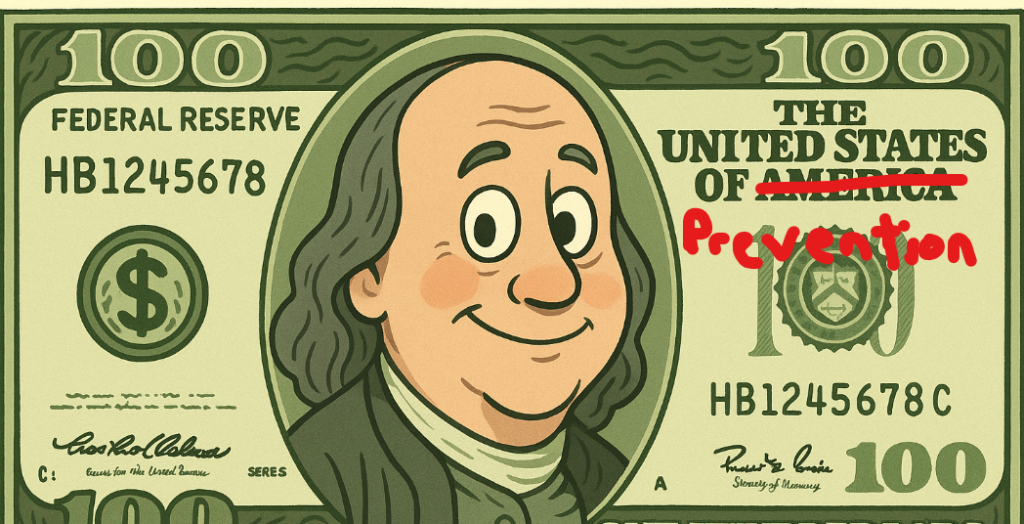
Prevention Pays Off – In Dollars and Lives
The bottom line: Investing in public health prevention pays for itself.
This is a message we NEED to hit over and over as the current public health infrastructure is systematically dismantled.
A large body of U.S. research shows that every dollar spent on effective prevention programs yields many times more in savings on healthcare costs and other social expenses. Put simply, preventing disease is far cheaper than treating it after the fact. Prevention is like changing a car’s oil—far cheaper than replacing the engine.
By focusing resources “upstream” on keeping people healthy, we can avoid costly hospitalizations, chronic disease care, and lost productivity down the road. In fact, one review of dozens of studies calculated that each $1 invested in broad public health efforts saves roughly $14 in medical and societal costs on average. This kind of return on investment (ROI) would make any Wall Street investor take notice – and it’s all achieved by saving lives and preventing suffering at the same time.
Vaccinations Deliver Billions in Savings
Vaccines are one of the clearest examples of the value of prevention. Thanks to immunization, diseases like polio and measles that once killed or disabled thousands are now largely under control—and the economic benefits are massive.
The CDC reported that for U.S. children born from 1994–2023, routine vaccinations prevented 508 million illnesses and 1.1 million deaths, while saving $540 billion in direct medical costs and $2.7 trillion in total societal costs. That’s about $11 saved for every $1 spent on childhood vaccine programs.
Programs like Vaccines for Children, which provide free vaccines to low-income families, have been essential to achieving these returns. Immunization remains one of the best public health investments: every dollar spent saves many more and protects lives at the same time.
Tobacco Prevention: A Clear Win-Win
Preventive efforts in tobacco control also deliver striking economic benefits: all the more striking considering the recent shuttering of the CDC’s Office of Smoking and Health. Smoking-related diseases cost the United States over $289 billion each year in healthcare and lost productivity – a colossal burden that falls heavily on public programs like Medicare and Medicaid. Every smoker who quits or never starts represents future savings in heart disease, cancer, and emphysema treatments. That’s why initiatives to reduce smoking are considered “best buys” for public health.
For example, the FDA’s “The Real Cost” media campaign (aimed at preventing youth smoking) is estimated to have averted 350,000 new teen smokers between 2014 and 2016, which in turn will save more than $31 billion in long-term health costs. Remarkably, the program spent about $247 million on advertising – meaning an ROI of roughly $128 saved for every $1 invested in the campaign.
Similarly, the CDC’s “Tips From Former Smokers” campaign – a national ad campaign featuring real people affected by smoking – helped an estimated 100,000 Americans quit smoking in its 2012 run. The CDC found Tips spent only about $480 per smoker who quit (and just $393 per year of life saved), making it one of the most cost-effective health interventions ever, far below the commonly accepted $50,000 per life-year cost-effectiveness benchmark.
States also see benefits: quit-lines and local cessation programs yield between $1.26 and $2.50 in savings for every $1 spent, with long-term savings accumulating as fewer people smoke.
Chronic Disease Prevention: Bending the Cost Curve
Chronic diseases like heart disease, diabetes, cancer, and obesity are the leading drivers of U.S. healthcare costs, accounting for about 90% of the nearly $5 trillion the nation spends on health each year. This means that even modest gains in preventing chronic illness can translate to huge financial savings.
Fortunately, numerous prevention initiatives targeting chronic conditions have proven their worth. A landmark analysis by Trust for America’s Health projected that investing just $10 per person per year in community-based disease prevention programs (for example, programs promoting physical activity, better nutrition, and smoking reduction) could save the country more than $16 billion within five years – a return of $5.60 for every $1 invested. These savings come from reducing the burden of diseases like type 2 diabetes, hypertension, and others before expensive complications arise.
Concrete programs back up these projections. Take the National Diabetes Prevention Program (National DPP) as an example: this program enrolls adults with prediabetes in coaching and lifestyle classes to help them eat healthier, exercise, and avoid progressing to full diabetes. Evaluations show it is highly cost-saving. In one large real-world study, participants who went through a DPP lifestyle change program had, on average $4,552 less in healthcare spending over the next two years compared to similar individuals who didn’t – largely due to fewer hospital visits and medications needed.
Even more striking, for each case of type 2 diabetes actually prevented, the researchers estimated about $160,000 in medical costs were averted (reflecting the lifetime expense of managing diabetes and its complicationas). In another analysis of commercially insured adults, offering the DPP was projected to achieve a 42% ROI within three years due to the avoided costs of diabetes treatment.
Community programs that reduce high blood pressure, smoking, and obesity show similar results, saving both Medicare and private payers money in the near term and reducing expensive complications over a lifetime.
Mental Health Promotion: Returns in Productivity and Reduced Costs
Mental health is as critical to prevention as physical health. Untreated conditions like depression and anxiety cost the U.S. hundreds of billions each year in treatment, lost productivity, and disability.
In fact, researchers have estimated that untreated mental health issues cost the global economy around $1 trillion each year in lost productivity, and in the U.S., they account for hundreds of billions in medical spending. The encouraging news is that investing in mental health care pays for itself many times over. A World Health Organization-led analysis found that every $1 put into scaling up treatment for common mental disorders (like depression and anxiety) yields about $4 in economic returns. These returns come from people being able to work, earn, and participate in life more fully when their mental health is supported – as well as from lower emergency care and disability costs.
Closer to home, U.S. employers are seeing similar results. Companies that provide robust mental health benefits and preventive services (such as counseling, stress management programs, and substance abuse treatment) report an average return of about $4 for every $1 invested in employee mental health programs. This ROI accrues through reduced healthcare claims (since mental health treatment can prevent costly medical episodes), higher on-the-job productivity, and less absenteeism. In one case, a major health system achieved over a $10-to-$1 return after expanding mental health support for its 18,000 employees.
Investing in school-based programs, community mental health clinics, and insurance coverage for counseling not only saves money but also prevents crises like suicide or addiction, outcomes that are priceless to avoid.
Early Childhood Interventions: Lifelong Returns
Prevention is especially powerful when it begins early. Early childhood interventions, such as prenatal care, infant nutrition, and parenting programs, yield benefits that last a lifetime.
A prime example is evidence-based home visiting programs for new parents, such as the Nurse-Family Partnership (NFP). In NFP, trained nurses regularly visit low-income, first-time mothers during pregnancy and the child’s first two years, coaching parents on healthy practices, childcare, and coping skills. Studies over decades have found this model produces remarkable returns on investment. By helping prevent preterm births, childhood injuries, developmental delays, and even future delinquency, home visiting yields an estimated $5.70 in benefits for every $1 spent. Those benefits come in the form of reduced healthcare costs (healthier moms and babies mean fewer NICU stays and ER visits), lower child welfare and foster care expenditures (due to decreased child abuse and neglect), better school outcomes, and even higher earnings when those children reach adulthood.
Other early interventions show similar economic promise. High-quality early childhood education programs, for instance, have demonstrated long-term returns ranging from approximately $4 to $9 per dollar invested, as they reduce later needs for special education, public assistance, and involvement with the criminal justice system. In health terms, initiatives like early childhood nutrition assistance (e.g. the WIC program) reduce rates of low birth weight and related medical costs. Immunizing toddlers, ensuring lead-free homes, and providing parenting classes are all preventive steps that save multiples of their cost down the road. For policymakers, the takeaway is that every dollar spent to give children a healthy start in life is not just a moral investment but a fiscally wise one.
These programs produce healthier, better-educated citizens who require fewer remedial services – paying back dividends to society for decades after that initial investment in their early years.
The ROI of Prevention: A National Portfolio
Looking across interventions, the numbers are consistent:
- Tobacco prevention campaigns: ~$0.5B invested → ~$64B in savings annually.
- Community prevention programs: ~$3.4B invested → ~$16B in savings within 5 years.
- Diabetes prevention (DPP): ~$2M participants → ~$4.6B in savings over 2 years.
- Home visiting (NFP): ~$1.8B invested → ~$10B in long-term benefits.
Even with conservative overlap adjustments, these programs deliver returns of 5:1 to 9:1—and align with systematic reviews showing median ROI around 14:1 across public health interventions.
Few other public investments generate this level of return while also saving lives.
Bottom line for policymakers
For policymakers looking to rein in healthcare costs while improving health, prevention is one of the smartest fiscal choices available.
Funding immunization, smoking cessation, nutrition programs, mental health counseling, and early childhood health initiatives consistently produces high ROI. These investments reduce hospital bills, lighten the load on Medicare and Medicaid, strengthen the workforce, and build healthier communities.
Prevention is a necessity. It saves money, enhances lives, and extends life expectancy. Spending wisely now ensures a healthier, more prosperous America tomorrow.
The choice is clear: prevention isn’t a cost. It’s an investment with guaranteed returns.



